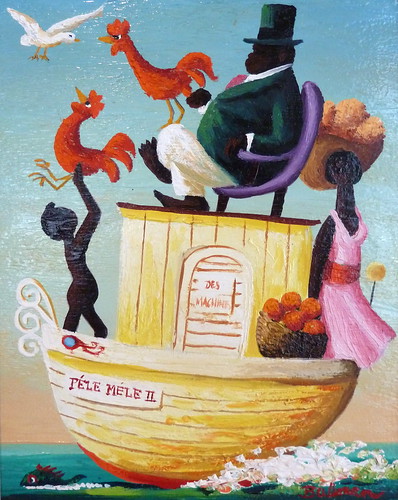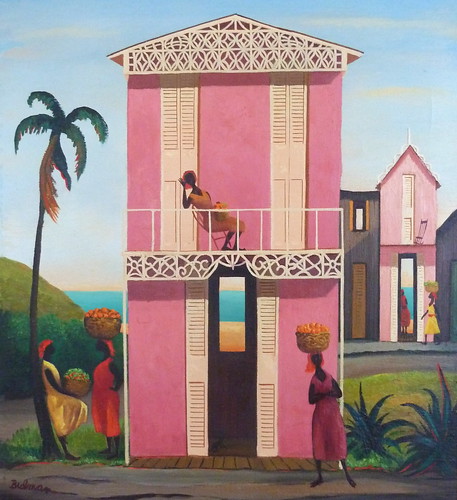Haiti and the Midwestern Imagination Opens at Lynden
For immediate release: 7 March 2012
For further information: Polly Morris, (414) 446-8794
pmorris@lyndensculpturegarden.org
http://lyndensculpturegarden.org/press
For images, click here.
HAITI AND THE MIDWESTERN IMAGINATION
Paintings by Orville Bulman on View through May 13
The Lynden Sculpture Garden, 2145 West Brown Deer Road, Milwaukee, WI 53217, has opened Haiti and the Midwestern Imagination, an exhibition featuring the Haiti-inspired paintings of Orville Bulman. The exhibition remains on view through May 13, 2012.
Haiti and the Midwestern Imagination examines the role played by Haiti in the imagination of Orville Bulman (1904-1978), a Midwestern businessman-turned-artist, and his patrons. Set primarily in the 1950s, when Haitian cultural export—particularly of what is now referred to as first generation Haitian art--was on the rise and the country was opening itself to tourism, and when Americans were awash with a postwar optimism that celebrated America’s political and economic power, it tells us relatively little about Haiti at mid-century and a great deal about the ways Americans saw themselves and the rest of the world.
As an artist, Orville Bulman was not so much self-taught as self-made; he worked assiduously to create and perpetuate his own narrative, and he made liberal use of contemporary American stereotypes of businessmen and artists to define his niche in the art market of the ‘50s and ‘60s—a market in which Abstract Expressionism was the reigning avant-garde. For Bulman, Haiti—which he visited for 12 days in 1952--was the source of a visual vocabulary, a style, and a sense of himself as a professional artist that sustained his career for more than 25 years.
The exhibition is comprised of ten paintings by Orville Bulman, primarily from the 1950s; the majority of them are from the Bradley Family Foundation collection. Also on view: three watercolors of Haiti by Emilio Sanchez, also from the 1950s.
Haiti and the Midwestern Imagination is held in conjunction with Haiti 2012: Dreams and reality € pays rêvé, pays réel: (March 5-9, 2012), a celebration of contemporary Haitian art, cinema and literature. More details on the conference here: http://www4.uwm.edu/cie/haiti2012.
About Orville Bulman
Orville Bulman was born in Grand Rapids, Michigan, in 1904. During Bulman’s childhood, his father invented products for the retail industry that became the foundation of the successful E.O. Bulman Company. The younger Bulman returned to Grand Rapids to work in the family business after spending a year after high school in Chicago, working as a cartoonist. It was not until the late ‘30s that his paintings--cityscapes and genre scenes--began to see the light of day. Around 1946, Bulman began to rearrange his life to put painting, rather than the family business, at its center. He started to spend his winters in Palm Beach, Florida, but continued to direct his businesses. Early on, Bulman sought out Eric Lundgren, an artist in West Palm Beach, as a teacher; he also spent brief periods at Oxbow in Saugatuck, Michigan and the Woodstock Art Colony in New York. At the latter, he formed a friendship with Adolf Dehn, an artist who spent time in Haiti in 1948 and 1949, and who may have piqued Bulman’s interest in the island and Vodou. By 1950 Bulman had launched a career of solo shows at galleries that continued unabated until his death in 1978. While his earliest shows were in Palm Beach, Grand Rapids, Madison, Wisconsin, Wilmington, Delaware and Knoxville, Tennessee, by 1955 he was exhibiting in New York (first at the Grand Central Art Galleries, and then at the Hammer Galleries) with Chicago, Paris and Los Angeles following before the end of the decade. By his own account, Bulman had had 40 one-man shows and sold about 2000 paintings by 1975.
About Emilio Sanchez
Emilio Sanchez was born in Camagüey, Cuba in 1921. He moved to New York City in 1944 and began studying at the Art Students League. Though he lived in New York until his death in 1999, it was in Cuba that he became fascinated with the play of light and shadow on colored forms, a dominant characteristic of his works. The watercolors in this exhibition are among his early stylized, figurative works. Sanchez had over sixty solo exhibitions and was included in numerous group shows in museums and galleries in the United States, Latin America and Europe. His art is in private and public collections including the New York Museum of Modern Art, the Metropolitan Museum and the Philadelphia Museum of Art. He received first prize at the 1974 Biennial in San Juan, Puerto Rico.
Images

Bateau Rapide (Swift Boat), n.d. (purchased 4/57)
Oil on canvas


